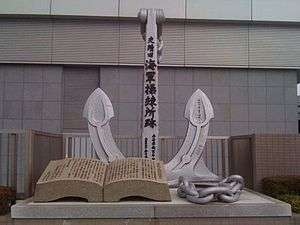Kobe Naval Training Center

The Kobe Naval Training Center (神戸海軍操練所 Kobe Kaigun Sōren-jō) was a naval training institute in Bakumatsu period Japan, established by the Military Commissioner of the Tokugawa shogunate, Katsu Kaishū in May 1864.[1]
Following the closure of the Nagasaki Naval Training Center by his political opponents within the Tokugawa shogunate, Katsu Kaishū made a visit to the United States aboard the Japanese steamship Kanrin Maru, and returned even more determined that Japan needed to build a modern navy in order to prevent colonization by the Western imperialist powers. He obtained official permission to establish a training school at what was then the small fishing village of Kobe in Settsu Province with the three-fold purpose of creating an officer’s training academy, a shipyard for the construction of modern warships, and a modern seaport.
From the beginning, Katsu encountered opposition to his plans from within the shogunate, and as official funding was withheld, he was forced to support the center largely out of his own funds and the donations of a few sympathetic daimyō. The presence of a large number of pro-Sonnō jōi rōnin within the membership of the center also brought the project under suspicion, especially in the wake of the Kinmon Incident and the Ikedaya Incident, and the center was closed in mid-1865,
A number of students of the Kobe Naval Training Center subsequently went on to play a major role in the Meiji Restoration, including Sakamoto Ryōma, Mutsu Munemitsu and Itoh Sukeyuki.
See also
- Nagasaki Naval Training Center
- Tsukiji Naval Training Center
References
- Frédéric, Louis. Japan Encyclopedia. Belknap Press of Harvard University Press (2005). ISBN 0-674-01753-6
External links
Notes
- ↑ Gow, Military intervention in pre-war Japanese politics, page 36
Coordinates: 34°41′08.75″N 135°11′36.54″E / 34.6857639°N 135.1934833°E